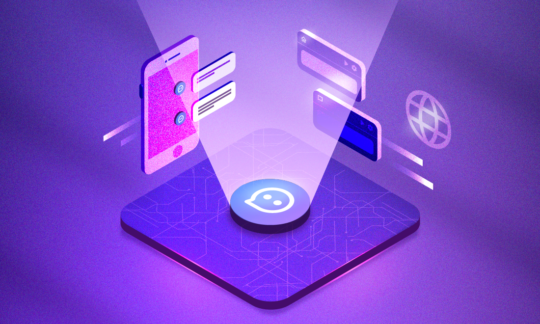7 Steps to Launch and Land an Award-Winning Chatbot for Customer Service
Table of contents
- Ensure a Great User Experience
- Involve Your Users in the Final Stages of Chatbot Design
- Create a Buzz – Introduce the Bot to Your Audience Ahead of Time
- Run the Post-Launch Promotional Campaign
- Provide Special Offers and Discounts
- Enter Competitions to Elevate Your Customer Service Chatbot
- Offer Regular Updates to Boost Trust in Your Chatbot/Voice Bot
- Build a Bot People Want to Talk to with SentiOne Automate
- Article Summary
Putting in the time and effort to develop and release an effective chatbot or voice bot only truly makes sense if your customers want to engage with it. Otherwise, you end up with a pointless investment, sunken costs, and unsatisfied stakeholders.
In this part of the AI Bots – A Manager’s Handbook Series, we’re shifting the focus from what we discussed previously, namely internal communication concerning chatbot implementation and addressing a far larger (and more important) audience: your customer base.
So, how to introduce your new bot to your clients? Read on to find out.
The Argument for Customer Service Chatbots and Voice Bots
Laying out the entire bigger picture in front of you before committing to a major investment is a crucial step for road-mapping every potentially drastic and long-term shift in your company’s operations. Since implementing a customer service chatbot very often implies such a paradigm shift, you’ll need to be aware of all the benefits it can bring.
First off, great chatbot design is synonymous with providing great customer experience, or CX. 97% of all consumers believe customer service interactions play an impactful part in shaping customer loyalty. As such, there’s no denying that striving to always provide the best quality CX is a must for any company wishing to stay afloat and prosperous, regardless of your company’s industry.
One aspect of customer service that will always pop up as an important factor in determining its quality is the response time. A human agent can only service one call at a time, while a customer service bot’s throughput is essentially limitless. This plays fantastically well into the fact that 62% of customers would prefer resolving their issue with a bot rather than having to wait 15+ minutes for a live support agent.
But shortening wait times down to nothing is just the tip of the iceberg when it comes to conversational AI for customer service. Chatbots increase the number of resolved tickets, can be taught to upsell or cross-sell, contribute to lead generation, and all that on top of lessening the strain and burden placed on your (likely already very busy) customer service team, saving hundreds if not thousands of man-hours.
Keep in mind, however, that while chatbots are extremely versatile tools, you can’t expect them to work as a factory-made Swiss army knife without putting in some extra work yourself. To work properly, a great chatbot needs:
- An optimised NLU able to process customer inputs accurately, including the most prevalent use cases, while not faltering when faced with controversial inputs;
- Reliable systems that don’t crash regularly or unexpectedly, putting the customer service bot out of order;
- A persona that functions as both a direct brand touchpoint and an extension of your brand, meaning you should give it a name, make it easily identifiable through visuals, and be consistent with the qualities your brand is known for.
- To be where your users are. Deploying the chatbot within a single channel likely won’t bring the most ROI (unless that’s where 99% of your users congregate), so spend time identifying the platforms and tools most frequently used by your target audience.
Think of the above as a rudimentary checklist; only after each individual item has been planned, tested, and implemented can you start considering introducing your bot to the audience.
Below, we gathered 7 steps to a successful chatbot/ voice bot launch. Follow these tips to create an award-winning bot!
1. Ensure a Great User Experience
First things first. In today’s world, not ascribing significant value to UX can be equal to denying yourself access to as much as 35% of revenue. Needless to say, when launching a new product or service, like a chatbot, taking extra time to develop its UX is an important piece of the puzzle that you’d be remiss not to devote enough attention to when launching.
From a UX perspective, it’s critical to design an engaging chatbot experience that avoids confusion and frustration for users. A good first step is to program in a welcoming message clearly explaining what the customer support bot can and cannot do. Additionally, providing an option for users to always switch to a human live chat agent helps build trust and reassures them that other forms of support are available if needed. And it will be, for it’s virtually impossible for any customer service automation efforts to handle all requests without fail right out the gate.
Other UX best practices include an apology message when the bot does not have an answer or can’t perform the requested action (“Sorry, I wasn’t trained to talk about this subject. However, I’m happy to help you with…”). Always maintain a friendly and positive tone in your responses. Even a little bit of small talk or self-deprecating humour, when properly incorporated, can encourage users to keep using the chatbot.
2. Involve Your Users in the Final Stages of Chatbot Design
Everyone likes to feel included from time to time, and while naturally, you wouldn’t hand the reins to your client when dealing with principal design elements, a nod to the key part they play in your business won’t come off as an out-of-place gesture, quite the opposite. When you’re nearing the end of the design process, consider polling your clients on social media on cosmetic aspects of your customer service bot, such as the name, aspects of its visuals, or something related to the colour scheme. This will make the users more invested and interested in your conversational AI solution.
3. Create a Buzz – Introduce the Bot to Your Audience Ahead of Time
Don’t expect sparks to fly and applause to thunder if the lead-up to your chatbot’s launch day is next to non-existent.
Preventing that from happening should be fairly easy, but only if you take these steps to heart:
- Start with a dedicated landing page explaining your excitement for the launch of your chatbot, and take extra care to present it gracefully and with a friendly tone. Trying to shove it down your customer’s throats won’t go over well.
- Put yourself in your customers’ shoes, and think about what might stop them from wanting to interact with it. Anticipate problems or doubts they may have about the bot, and dispel them away with a proper messaging (a FAQs section at the bottom of the landing page should also work).
- Lastly, create an introductory video to present to your clients what exactly the bot can help them with. This helps temper the expectations of those clients with overly robust imaginations and avoids confusion in the long run.
To see it done right, look no further than Cora. The Royal Bank of Scotland leaves no questions unanswered on their bot’s landing page, fully explaining Cora’s capabilities, features, and limitations, all wrapped in warm, approachable, and courteously explanatory language.
4. Run the Post-Launch Promotional Campaign
Once your virtual assistant is ready to go out into the world, it’s important to really engage your users to popularise the chatbot and increase usage. After all, an unused chatbot only accumulates gradually more proverbial dust instead of being a useful part of your business. In other words, it ends up bleeding you money, so do everything in your power to counteract that by promoting it.
The most obvious way to do that is through your social media channels, as it’s a surefire method of reaching a significant majority of your clients in a short amount of time. Run paid campaigns enticing your users to try out your new service – the chatbot or voicebot – and highlight the benefits they can take advantage of. Remember to reach your clients wherever they are – on Facebook Messenger, WhatsApp, your mobile app or website etc. Cover all the bases.
When Sephora launched its chatbot alongside a promotional campaign, it reportedly saw an 11% increase in interest in its makeover service. Talk about a new look!
While digital promotional campaigns will certainly have the most impact, they’re not the only method to spread the word. Going offline to boost chatbot adoption can certainly pay off as well, depending on your business model. How? For instance, you can include a QR code on your leaflets or a physical product you sell and use it to lead your users directly to the chatbot.
5. Provide Special Offers and Discounts
Encourage your audience to engage with your chatbot or voice bot even more by providing special offers and rewards. For example, you could give them 10% off their next purchase for being the first 100 clients who interact with the bot, or give them a special promo code, only available via a chat. Depending on your business model, you could also offer them a free subscription for the first month, or have some fun and create a special contest for the bot users.
6. Enter Competitions to Elevate Your Customer Service Chatbot
Think your chatbot could win an award? Why not submit it for a competition?
Awards definitely up the prestige factor of your product (see the next point). If you’ve been regularly following the tips and tricks we give to bot designers and managers such as yourself across our content, then you’ve undoubtedly created a solid and reliable chatbot for customer service. Winning a competition would bring significant benefits to your company, boosting brand reputation, generating publicity, and showing that your team of dedicated professionals is committed to driving innovation in the field of conversational AI. Plus, it simply feels good to proudly exclaim you created an award-winning chatbot. Overall, it’s a fantastic PR boost.
As an example of what you can achieve with the help of SentiOne Automate, Alior Bank’s InfoNina, a voicebot we helped create, has recently won yet another award, and, dare we say, a well-deserved one at that. The virtual assistant handles 100% of incoming helpline calls and can recognize up to 650 intents!
7. Offer Regular Updates to Boost Trust in Your Chatbot/Voice Bot
Don’t be shy to advertise your successes. Any major statistical win or award can turn even the most disinterested or sceptical clients into active chatbot/voice bot users (“After a year our chatbot is able to answer 400 queries and picks up 17k calls a day!”. Regularly keeping interested parties in the loop boosts engagement and interest in your chatbot. Just take a look at some real-life examples below.
CaixaBank, which operates in Spain, won an Analytics & AI award in 2019 for Neo, its AI-powered chatbot, serving customers 24/7 in 3 different languages.

CaixaBank won an Analytics & AI award in 2019 for Neo, its AI-powered chatbot.
In the UK, a company called FCM Travel Solutions won an award for their chatbot Sam, thanks to its seamless blend of AI, personalisation, and all-around trip management services.

FCM Travel Solutions won an award for their chatbot Sam.
Shifting the focus to the startup scene, in 2017 a fintech company called Cleo received a £2m valuation for its finance-managing AI chatbot, thanks to which 77% of customers were able to completely stop using their banking apps.

A fintech company called Cleo received a £2m valuation for its finance-managing AI chatbot.
Peering across the globe, Singaporean banking corporation DBS Bank won a series of awards for Joy, their bank’s virtual assistant. In 2019, Joy was said to handle 80% of total customer inquiries, leading DBS to a 128% monthly brand-new chatbot adopters among their user base.
Build a Bot People Want to Talk to with SentiOne Automate
SentiOne Automate allows you to create a chatbot or a voice bot that meets all of your business needs and the expectations of your clients. Thanks to versatile models that have been pre-trained on billions of real conversations, our solutions can be tweaked, adjusted, and tailor-made for use in any industry. Book a demo now, or take a look at the potential chatbot ROI you’re leaving on the table.
Article Summary
Implementing a successful chatbot or voice bot for customer service requires strategic change management to ensure adoption. Benefits include improved customer experience, reduced response time, increased ticket resolution, lead generation, and team efficiency. Key factors for a great chatbot include optimised NLU, reliable systems, user-friendly design, consistent persona, and multi-channel deployment. To successfully introduce your bot to your audience, ensure a positive user experience, involve users in design decisions, create pre-launch buzz, run post-launch promotional campaigns, offer special discounts, provide regular updates, and consider entering competitions.



